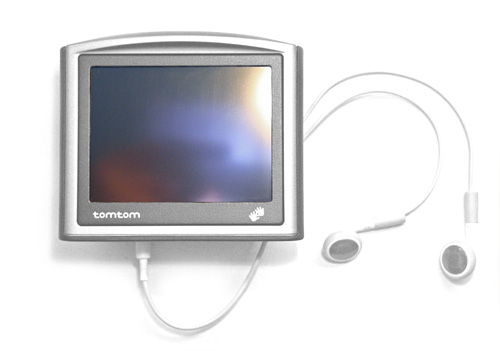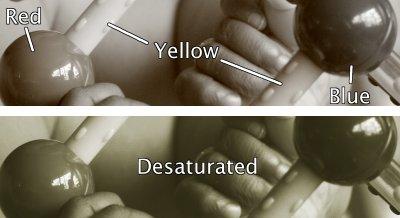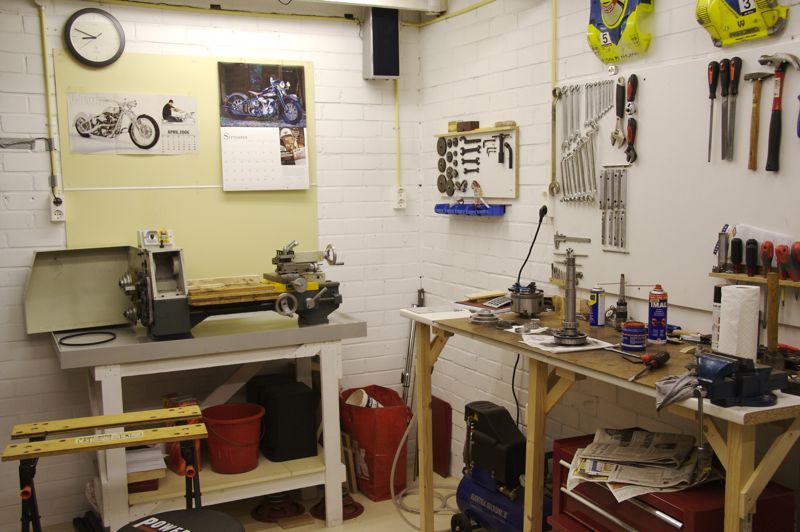I know you’ve been playing with your ultra-cool iPhones, but did you realize that it only is 6 years ago that Apple showed is the first iPod? It’s amazing how fast technology advances nowadays. Today I read that 128GB flashdrives are not far away, so how about an 128GB iPhone, or even a MacBook with a solid state disk? We’ve got a nice future ahead…
Category: Hardware
Lathe Spindle rebuild, part 1
 Past few weeks I noticed that the spindle bearings of my lathe were becomming warmer than I liked, particularly when working with higher rpm. Last weekend I decided to take the spindle out, clean the old grease out, and rebuilding it. It turned out to be more work than I expected. The tight fit of the pully made me use the hammer-and-wood trick on the spindle, which I did not like. After a few hours of tapping and fiddling, the pully came of. The spindle gear and the left hand bearing were no fun job either.
Past few weeks I noticed that the spindle bearings of my lathe were becomming warmer than I liked, particularly when working with higher rpm. Last weekend I decided to take the spindle out, clean the old grease out, and rebuilding it. It turned out to be more work than I expected. The tight fit of the pully made me use the hammer-and-wood trick on the spindle, which I did not like. After a few hours of tapping and fiddling, the pully came of. The spindle gear and the left hand bearing were no fun job either.
Anyway, the whole thing is apart now, and I cleaned out all the grease. I test-fitted the spindle sundaynight, but I can feel a slight “bump” when turning it, I think the grease must have picked up some dirt, most likely a wood chip from the bench. So I have to take it apart again, it has to be perfectly smooth.
After I re-fit the spindle, I have to adjust it with my micrometer to have a play of between 0.004 and 0.005 mm, no more, and no less, while being able to turn it by hand. Sounds like an interesting excercise which will take up more than a few minutes 🙂
TomTom One v2 earphone modification
 TomTom decided to remove the earphone plug from their newer version One. This blog entry will describe how you can add your own.
TomTom decided to remove the earphone plug from their newer version One. This blog entry will describe how you can add your own.
Why would TomTom remove the earphone plug? There are a few simple reasons, one being that the new version has a slimmer formfactor with less room for plugs, and the other being that they probably don’t want it to compete too much with the XL and Rider versions.
Technology does not sell
Seth Godin did a talk at Google campus in Februari last year. I recently stumbled upon this video of his talk, in which he explains to the Google people why Google sells.
He is very clear in explaining to technology people that technology does not sell. It’s technology that gives you a shot at marketing, nothing more. He makes some very good points which I’ll try to summarize, because the video takes 48 minutes to watch 🙂
Give me spots on my Apples
 Lately Greenpeace has started a campaign against the usage of hazardous materials by Apple. The campain setup is friendly, nicely designed and urges Apple to choose materials which are less hazadous to the environment.As a spinoff of the Greenpeace campain all kinds of so called “journalists” have begun to put Apple on the “wrong end of the scale” of their “environment-o-meter”, and are happily writing doom articles about what will happen to your Karma if you buy any Apple product. But how environmentally unfriedly are Apple’s computers really?
Lately Greenpeace has started a campaign against the usage of hazardous materials by Apple. The campain setup is friendly, nicely designed and urges Apple to choose materials which are less hazadous to the environment.As a spinoff of the Greenpeace campain all kinds of so called “journalists” have begun to put Apple on the “wrong end of the scale” of their “environment-o-meter”, and are happily writing doom articles about what will happen to your Karma if you buy any Apple product. But how environmentally unfriedly are Apple’s computers really?
Samba shares and USB drives
I am very close to migrating the data on my bulky PC to my new Mac Mini fileserver and mounting the IDE drives in the USB drive brackets. Once I’ve done this, I will have the screenshots and data to write a nice “how to” on using the Mac Mini as a file server. There is however one slight problem which could prove to be a showstopper…
Samba test 1: local directories.
I created a directory in the root of the HD in the mac mini, and made it R/W for everybody. Then, I used SharePoints to make it available to all password-less Guest users on the network (which happens to be the default Windows user for connecting to drives without asking for a password). All was well. I could access the share, and could copy as many files from as many machines imultaniously as I wanted.
Samba test 2: USB mounted volumes.
I mounted a HFS+ formatted USB disk to the Mac Mini, and made it available to the network in the same way as in test 1. Everything seemed to be working fine and as expected, but while running some tests I discovered a strange thing: I can only copy files onto the USB drive from 1 machine at a time, 1 file at a time. When starting a new copy while allready in the process of copying an older file, one or both copy jobs crashed with a “file in use” error.
I am now trying to find out what is causing this problem. I have a firewire drive I can use to determine if it is the USB protocol or driver which is causing this problem, or if it is the fact that it is a mounted volume alltogether. If anybody has tips I’m glad to hear them. Meanwhile I’ll be searching the web…
Update
Using a firewire drive does not solve the problem. I did find some articles on fast user switching which state that only 1 user can access pheripherals at a time. This seems to be related to this problem.
Update 2
Creating a symlink to the mounted volume and sharing the link through samba will not change behaviour. I was expecting this, but tried anyway because it only costs 1 minute to test. Maybe a virtual drive would be an option. I can create virtual RAID disks in OSX, but I don’t want my setup to be complex. This will add to the complexity when recovering from a sever crash. Simple, full and fast recovery from hardware problems is my top priority.
Curing lens envy
Do you still want “that last lens and that’s it”? According to the statistics on this page, you probably already have the right lens in your camera bag. Chances are that you are using your cheapest lens most often. The best quote from this page must be “The cost of the lens is inversely proportional to the frequency of its use.”.
Where did I get that link from? Well, from a brilliant text by Ken Rockwel titled “Your Camera Does Not Matter”. It states that you may not only have overspent on lenses, but on your complete kit alltogether! According to Ken, “Buying new gear will NOT improve your photography.”.
 Next time you see a guy with a D200, don’t be impressed. The guy behind him with his old Holga camera could be shooting far better pictures!
Next time you see a guy with a D200, don’t be impressed. The guy behind him with his old Holga camera could be shooting far better pictures!
I have had a Canon EOS 300 (35mm film), a Canon Powershot A20 and now a Canon 350D. I also have made photo’s with some of my dad’s camera’s, a Canon FT-QL, and an Exa IIB. When changing from one camera to another, my photography (in particular composition) did not change. It just took some trouble away from the process. EOS 200 to Canon A20: no more film hassle. Canon A20 to 350D: Faster bootup and shot-to-shot times. Canon FT-QL and Exa IIB: The romantic feeling of craftsmanship when holding the camera 🙂
 Sure the 350D gives me nice resolution and more freedom to play with aperture and exposure times and I still like the camera after reading Kens article. But he is right. Period. I recently spoke to a guy who owned an EOS 300 just like I did. He looked at one of my photo’s from the 350D and said “I’ve got to have that camera, how did you do that?”. I explained “aperture” to him and told him that he could do that with his own EOS 300 if he had taken the time to learn how to use it.
Sure the 350D gives me nice resolution and more freedom to play with aperture and exposure times and I still like the camera after reading Kens article. But he is right. Period. I recently spoke to a guy who owned an EOS 300 just like I did. He looked at one of my photo’s from the 350D and said “I’ve got to have that camera, how did you do that?”. I explained “aperture” to him and told him that he could do that with his own EOS 300 if he had taken the time to learn how to use it.
I guess some sales people translate “I want a good camera” to “I want to spend a truckload of cash on a camera of which I’ll only use the full-auto mode to shoot pictures of uncle Zed with.” People who don’t know what “aperture” or “exposure time” means just want a snapshot camera which automatically will produce clear, colorful, crisp foto’s of uncle Zed 95% of the time.
Before buying a camera, read Ken’s article, get out of that chair and start shooting with whatever camera you have right now. That one brilliant moment is waiting for you!
Free Beanbag!
When you are using a (digital) camera and need to place it on an uneven surface to keep it still long enough for your long shutter speeds, or you want to make a shot on the release timer (or both), you’ll need a tripod, or a beanbag. A beanbag is an ideal option, you can tuck it into your backpack, take it everywhere you need and it fits all camera’s.
Sure, you can buy a beanbag from a nice company like this, and spend about 30 euro’s or more. But, If you’ve got a needle, thread, a T-shirt or linnen bag, and some rice, you can make one for free!
Canon 350D B/W Sepia
Once in a while I like to take black and white pictures because the EOS has a nice built in set of color filters. The easiest example of a nice black and white photo where a color filter produces great results is the classic “blue sky with Yellow filter”. You should really check out the great tutorials on Cambridge in Color.

When shooting in B/W mode, I often use the “sepia” filter, to add a little warmth to the photo. A wierd thing I noticed lately about the EOS 350D (besides the film transport sound) is that “Sepia” mode is not really producing pure B/W Sepia images. There is color seeping through! In the top image, you can clearly see residues of red, yellow and blue in a photo of a baby toy (cropped for privacy reasons). The bottom image is converted to pure B/W on a computer and then sort of “Sepia”-d using a hue/saturation tool just for reference.
I read on some forums that camera effects are generally not as good as the effects in image processing programs like PhotoShop or GIMP. This is supposedly because speed/quality tradeoffs. I really like to spend more time with the camera than post-processing, so I’d like to keep using the in-camera effects. A great tip I read somewhere on a forum is to shoot in RAW+JPG mode. The JPG will have all the processing done by the camera, and the RAW will be the raw data from the sensor. Depending on the results of the in-camera effects, you either keep the JPG, or use the RAW image to do the effect in GIMP later on.
Mac Support… is… slooowww
As you’ve probably read, my brand new Mac Mini has a memory problem. I have brought it in for repair, but I am “slightly irritated” by the speed at which the guys from the www.macsupport.nl stores pick things up.
| Friday, May 6th: | I’ve found out that the mini has a consistent, reproducable memory problem. I suspect a technician could even tell which of the two memory modules it is judging from the faulty address (faulty single bit even, for the technical readers amongst us). It’s late in the evening so I have to wait for the next day to call. I printed out a screenshot of the memory error and location, and put that in the box with the mini, to make sure they have a clear problem description. |
| Saturday, May 7th: | Started calling the shop. They state that the tech support guys are not in on saturday. Strange, since they installed the memory modules on a saturday when I bought the thing. Can’t the same guy swap out both modules so I have my machine back? Finding out which module is faulty can be done in the shop without me waiting. No apperantly not. I tried to call 3 of their shops, of which Amsterdam didn’t even return my call even though I asked the operator to tell them to call me back. |
| Sunday, May 8th: | Although the shop in Amsterdam claims to be open, they are to busy to pick up the phone. |
| Monday, May 9th: | I tried to call the new shop in Haarlem, but I get a “Sorry all lines are busy” message all day. At the end of the day I decide to drive to the shop. The shop is open, but they have network and phone problems (thanks to KPN, they claim). Because it is a new shop eveybody is uncertain as to what to do, and it takes me 45 minutes (!) to get the Mac mini to be taken in for repairs, even though I was helped the moment I entered the shop. They warn me that the repair is going to take a week (!). |
| Tuesday, May 16th | Still no call from the shop in Haarlem. When I try to call, I notice they still have the same phone line problems. So, I drive to the shop again to find out how the repairs are going. They in form me that my Mac is “scheduled for repair on the 19th”!. So it has been sitting there for almost 2 WEEKS! And then they haven’t even begun to look at the problem. They expect it to be repaired and ready to be picked up at Monday, May 22nd at the earliest. |
As you can read, this is not a happy start of my 1600+ euro Apple adventure. I really hope they can get their logistics and repair process in shape. I really like the Mac mini, but I sure don’t like the way Mac support takes their time to switch to memory modules and run a diagnostics tool.



